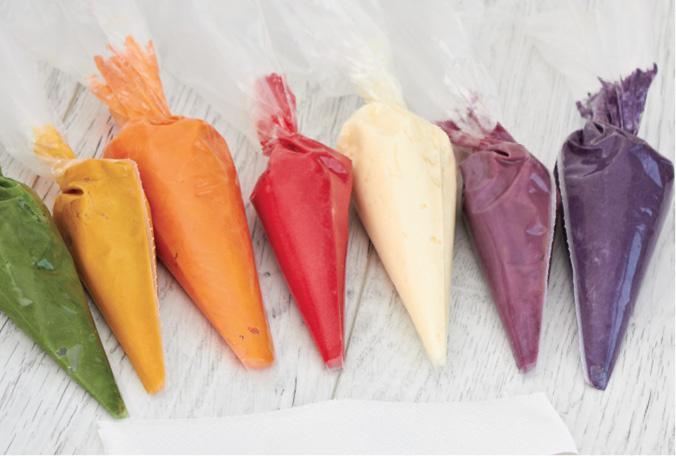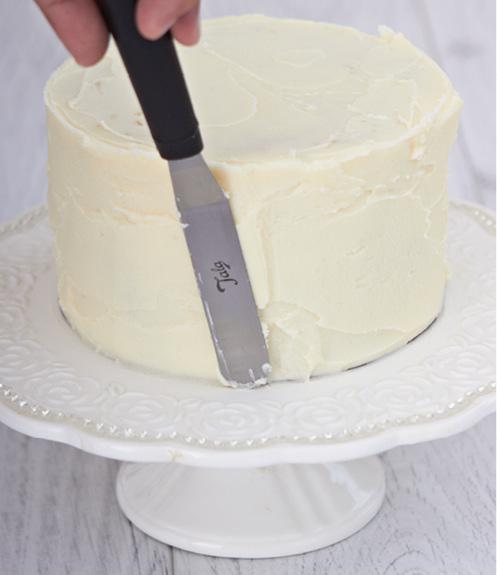Read The Contemporary Buttercream Bible Online
Authors: Christina Ong Valeri Valeriano
The Contemporary Buttercream Bible (5 page)

Tip
Some designs will require you to fill a piping
bag with more than one colour of buttercream.
In this case it is best to put each colour into a
separate piping bag and then pipe them into a
new bag (see Up and Down Two-tone Ruffles
in Piping Textures and Patterns).
47

48
Inspirations
We are always asked, ‘Your cakes are all unique –
where do you get your inspiration from?’ Our secret
is simple. We get inspiration from anything
beautiful
and
interesting,
from
absolutely
everywhere! Look around you, and if a certain
colour or design catches your eye the next thing you
should do is imagine how you will put it on your
cake.
49

50
Covering Cakes
Here we will discuss how to cover your cake
properly, making sure that the buttercream sticks to
the cake and provides a clean base for any
additional decoration. Buttercream is physically
heavy and if you don’t learn to cover correctly, then the buttercream might fall off the cake. The first
essential stage is crumb coating, so we’ll begin
there.
Crumb Coating
As the name suggests, this is all about coating the
crumbs! This technique means applying a thin layer
of buttercream around your cake to secure the loose
crumbs, before adding the decorative layers and
features. This is a very important step that you
should not miss, as this makes your outer layer of
buttercream stick to the cake, giving the heavy
piped and textured designs something to adhere to.
51

1 You can use a palette knife to apply the
buttercream to the cake, but some cake sponges can
be very crumbly. When you use a palette knife, the
tendency is to keep pushing and pressing the
frosting and this might damage your cake. Instead,
we use a piping bag to apply the frosting (A).
A
2 Use a round nozzle or just snip the end off a
piping bag. Using the same frosting that will go on
the rest of the cake, fill the piping bag and pipe
52

around the cake with a good pressure so it sticks to
the cake (B).
B
3 Use your palette knife to spread the buttercream,
using even pressure (C).
53

C
4 Next you can use a cake scraper to level out the
thickness of the frosting and to remove any excess
(D).
54

D
Tip
It is best to put the cake in the fridge after you
have crumb coated it, for about 30 minutes to
an hour (or quick freeze it for 10–15 minutes)
or until the surface is hard enough to work on
before you apply any more buttercream
decoration.
55
Smoothing
After the cake has been chilled for a short while you can apply another layer of buttercream and create a
smooth surface. The thickness of this layer will be a matter of taste. To be able to perfectly smooth a
cake takes patience and practice. Trust us, you will
not be able to ‘perfectly perfect’ it on your first go, but after a while you will get so practised at it that it will become easy.
PALETTE KNIFE
This is the common way of smoothing a cake – no
fancy tool, just a palette knife. You simply have to
spread the buttercream frosting around the cake
using the knife. The finish though is not perfectly
smooth as the knife will leave few lines and ridges.
You can use any palette knife, straight or cranked,
and the best choice of size will depend on the size of your cake. We find it is best to use a short
crank-handled knife for most occasions. The
direction in which you spread doesn’t matter, but it
is important to remove any excess and to make an
even layer.
56

Tip
Applying a buttercream layer with a palette
knife will allow you to create an artistic finish.
Don’t expect the surface to be perfectly
smooth with this method.
57
CAKE SCRAPER
Make sure that the edge of your scraper is perfectly
smooth. Remember that any dent on your scraper
will be visible on your cake because buttercream is
soft and delicate. Using a plain edge scraper is a
fairly quick way of smoothing your cake. With the
cake on a turntable, hold the scraper upright and
perpendicular to the work surface, and run it
around your cake until smooth.
If your cake is tall you may need to use a longer
implement, such as a ruler, a big cake lifter or (the most effective tool we’ve found) an L ruler or 90
degree triangle ruler.
58

Tip
For best results we highly recommend that you
place your cake on a thin cake board that is
about 0.5–1cm (1⁄ –1
4
⁄2in) larger than the cake.
See photograph B below. As you run your
cake scraper around you can press against the
edge of the board, rather than on the cake
59
side, ensuring an even layer of buttercream
and preventing you from pressing too hard on
the cake.
NON-WOVEN CLOTH
The following technique is similar to the ‘Viva paper towel method’ that is being used to smooth
buttercream covered cakes in the USA. However, if
you don’t live in the States, you will need an
alternative that you can source locally, so we have
spent some time researching a product that can be
found all over the world. We tried and tried
different mediums until we came up with using a
non-woven cloth, which has a smooth side and does
not stick to the buttercream. Non-woven cloth may
come in plain white or with minimal design. A good
example of this is the interfacing fabric that is used in sewing. You can buy this by the metre or yard
